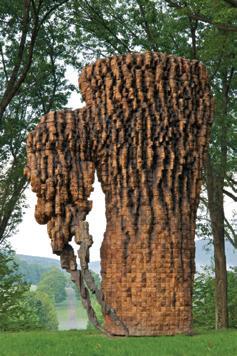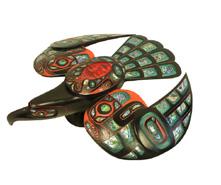
3 minute read
Against the Grain
Wood for Art’s Sake
Wood is easy to work with and it has many functional properties, but its aesthetic qualities also are ideal for decorative objects. Not surprisingly, woodcarving is a tradition that is as old as humanity. For centuries, many cultures have used wood to create works of art and religious icons, such as some of the Buddha sculptures of early China. Carved wood panels and statues have been discovered in several Egyptian tombs, and many other civilizations have a long history of working with wood. The earliest known example of wood sculpture is the Shigir Idol, a Russian artifact that is more than 11,000 years old; the larch object is carved with patterns that could be symbolic, but their meaning is still unsolved. In Canada and Alaska, the Indigenous peoples of the Pacific Northwest carve cedar totem poles to depict mythology and family lineage, while most Polynesian cultures – including Hawaiians – have a similar art form. Whether an object is symbolic or simply decorative, when it’s made with wood, it’s timeless. Here are four modern examples that use wood to elevate art.
Advertisement
In White Rock, B.C., California-based artist Gordon Huether created Rostrum, a wood and stainless steel sculpture using locally sourced cedar blocks. The amphitheater-like installation takes its aesthetic cue from the landscape and architectural design of the site, a former lumber camp turned residential development. Night lighting is provided by 50 inset LED bulbs, embedded into the steel pipes. Fabricating and installing this 10,000-lb. sculpture, which measures 14 ft. tall by 14 ft. wide, required intensive collaboration between the artist and structural and civil engineers, the project development team and the landscape architect. In addition, a team with expertise in international transportation and heavy hauling was consulted to facilitate the successful installation.
An internationally recognized sculptor based in New York, Ursula von Rydingsvard creates large-scale abstract forms that resemble geological formations, giant vessels, elements of the body or walls that evoke her experience growing up in Nazi slave-labor and refugee camps. Her pieces are in many permanent collections, including New York’s Metropolitan Museum of Art and Museum of Modern Art; Luba (shown) is displayed at the Storm King Art Center, an outdoor sculpture park covering hundreds of acres. Rydingsvard typically works with cedar (shipped from B.C.), composing her sculptures from networks of individual beams into which she and her team cut wedges, knobs and teeth using circular handsaws; the parts are glued and stacked together, and sometimes stained with pigments.
Canadian Indian Art offers one of the largest collections of West Coast Indigenous art, featuring dozens of artists from the Squamish Nation in B.C. A wide selection of wood carvings and other unique items can be purchased online. The Sun Carrier Raven Bowl (shown) by Jacob Lewis opens to reveal a hidden bowl; it is adorned with multiple inlaid paua shells from New Zealand. Lewis is a renowned artist who has been carving since childhood; his work has been displayed throughout North America. He uses yellow cedar to create complex designs, integrating the sun, ravens, eagles and other traditional symbolic images.
J. Paul Fennell began turning wood as a hobby in the 1970s while working as an engineer on the Apollo space program in California. Mesquite Basket (shown) is on display at the Smithsonian American Art Museum. Largely self-taught, his work focuses on hollow-turned vessels that are often inspired by “the natural world, family and architecture.” Fennell’s work explores texture, particularly his “pierced” pieces, in which he cuts out sections of wood to create forms that resemble intricate latticework. “My source of wood is salvaged from the local ‘urban forest,’ a resource that is amazingly diverse.” His works are in many museum collections, including the Museum of Art & Design in New York, the Museum of Fine Arts in Boston and the Carnegie Museum of Art.
1. Rostrum by Gordon Huether
Miramar Village/
White Rock, BC 2. Luba by Ursula von Rydingsvard
Storm King Art Center, NY 3. Sun Carrier Raven Bowl by Jacob Lewis
Canadian Indian Art (online) 4. Mesquite Basket by J. Paul Fennell
Smithsonian American
Art Museum, DC 1
2







